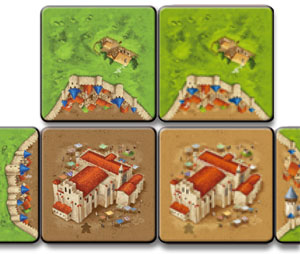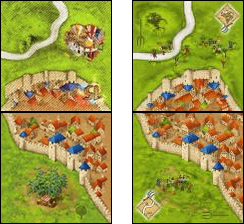Difference between revisions of "Visual Changes in the 2nd Edition/ru"
m (FuzzyBot moved page 2nd Edition Dark Cities/ru to Тёмные Города 2-го издания without leaving a redirect: Part of translatable page "2nd Edition Dark Cities") |
(Part of translatable page "2nd Edition Dark Cities") |
||
| Line 1: | Line 1: | ||
<languages /> | <languages /> | ||
The Second Edition of Carcassonne has undergone a few changes in style since its release in {{Year|2014}}. These minor graphic changes do not affect the payability of the game but the visual appearance of the board when combining tiles from different editions or styles. | |||
=== Более тёмные города Второго издания первого тиража === | === Более тёмные города Второго издания первого тиража === | ||
| Line 21: | Line 23: | ||
* [[Variants/ru#CutCassonne|CutCassonne]] | * [[Variants/ru#CutCassonne|CutCassonne]] | ||
* [[Variants/ru#Carcassonne_Demo-Spiel|Carcassonne Demo-Spiel]] | * [[Variants/ru#Carcassonne_Demo-Spiel|Carcassonne Demo-Spiel]] | ||
== Building-cluttered cities == | |||
[[File:Crowded_Cities_C2_Example.png|right]] | |||
Since late {{Year|2020}}, the new releases of the Second Edition of Carcassonne have changed the graphic style used for cities. Cities are more cluttered with buldings even overflowing the tile. These overflowing buldings are clipped at the tile edges. This causes a discontinuity at the city edges with clipped buildings, since the illustration is interrupted abruptly. | |||
So far, the original style featured buldings more sparsely distributed in cities. They would be near the edge of the tile but never overflowing it. | |||
In the example on the right, the two different versions are shown comparing similar tiles featuring original cities (left) and building-cluttered cities (right). | |||
'''Items known to have been produced with building-cluttered cities''' | |||
* [[The_Peasant_Revolts|The Peasant Revolts]] | |||
* [[Variants#20th_Anniversary_Edition|The 20th Anniversary Edition]] | |||
[[Category:Second Edition]] | [[Category:Second Edition]] | ||
Revision as of 21:45, 26 July 2021
The Second Edition of Carcassonne has undergone a few changes in style since its release in 2014. These minor graphic changes do not affect the payability of the game but the visual appearance of the board when combining tiles from different editions or styles.
Более тёмные города Второго издания первого тиража
Первые печатные версии Второго издания Каркассона (Template:Year ru-Template:Year ru) отличались более тёмным коричневым цветом основы для городов. Это также было использовано для первых двух крупных дополнений (Таверны и соборы и Купцы и зодчие), а также для некоторых рекламных материалов, доступных в то время. [Согласно нескольким постам на форуме Carcassonne Central] KJW потребовал, чтобы они были осветлены, и с тех пор все новые выпуски (начиная с Принцессы и дракона и далее), а также последующая перепечатка базовой игры и первых двух дополнений были представлены более светлыми городами.
В примере справа показаны две разные печати для одного из квадратов собора и нескольких окружающих его квадратов. (Изображение объединено из разных версий PDF правил для Таверн и соборов)
В фанатском сообществе версия с более тёмными городами называется Каркассон 2.0, версия с более светлыми городами - Каркассон 2.1.
На протяжении всей истории его производства были некоторые проблемы с согласованностью цвета между различными дополнениями, и это то, с чем мы, как игроки, должны стараться жить. Некоторые из нас могут иметь эстетические проблемы с объединением дополнений из двух разных тиражей, но квадраты остаются топологически идентичными.
Предметы, которые, как известно, были произведены с более тёмными городами
- Базовая игра
- Река (включена в Базовую игру)
- Таверны и соборы
- Купцы и зодчие
- Промо квадраты Essen Spiel (2014-2017)
- CutCassonne
- Carcassonne Demo-Spiel
Building-cluttered cities
Since late 2020, the new releases of the Second Edition of Carcassonne have changed the graphic style used for cities. Cities are more cluttered with buldings even overflowing the tile. These overflowing buldings are clipped at the tile edges. This causes a discontinuity at the city edges with clipped buildings, since the illustration is interrupted abruptly.
So far, the original style featured buldings more sparsely distributed in cities. They would be near the edge of the tile but never overflowing it.
In the example on the right, the two different versions are shown comparing similar tiles featuring original cities (left) and building-cluttered cities (right).
Items known to have been produced with building-cluttered cities

